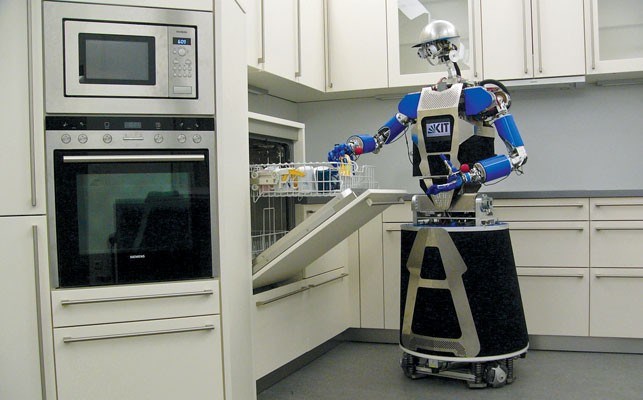In the '50s it was everybody's dream to hop in a spaceship — or at least a car that could fly — and go to the moon. That, and learn enough in Popular Mechanics to build your own robot to do all the chores you hated. This was especially true around the end of summer holidays when back-to-routine kicked in — school for the little ones, work for the rest.
If you were a kid, you'd dream about building some kind of genius robot that could do all your homework so you could hang out and play more. We have those now. They're called computers.
If you were a homemaker with any kind of imagination — meaning, you were a woman who'd forsaken your personal aspirations to stay home, cook meals, clean the house and raise the kids but you could picture something more — you'd dream about a robot that would help with all of the above. We have those now, too, and they're called robots.
Besides Popular Mechanics which, mercifully, is still being published, Daniel Ichbiah's exciting book Robots is a great place to suss out the kind of robot you might be needing.
First let's get this out of the way: Robots aren't new. People from way back were fascinated by the idea of an automated humanoid, or at least part of one, like a moving hand or a mask, to supersede our human limitations and make magic. In the ancient world, says Ichbiah, priests used moving masks and statues as "miracles" to hold sway over commoners and the ruling class. One creation in ancient Egypt was a moving mask in the likeness of the god Thot that doubled as the head of an ibis.
If you've been to Lund in Sweden you likely saw the old astronomical clock from the 1400s with the little knights that march out to do battle as the glorious old clock tracks time along with the paths of celestial bodies. Ancient clocks and watches with moving accessories are also early robots.
But we're all pressed for time, so back to those robots that might help you save some.
To start, the word "robot" comes from the Czech word robota meaning "forced labour." It was first used by the Czech novelist and playwright, Karel Čapek, in his 1920 play R.U.R. (Rossum's Universal Robots). It's perversely reassuring that something conceived to do forced labour can help relieve some of our own.
These days, developing domestic-service humanoid robots is all the rage at a number of tech centres and universities around the world. One of the most advanced is Armar, the humanoid robot developed at Karlsruhe Institute of Technology in Germany and now in its third generation.
Armar III is very cool. He — and he definitely is a "he" given his masculine signifiers, such as a baseball cap — is quite capable of visually distinguishing a mashed potatoes box from a rice box and whether the cup you want is red or green. Although he can't quite pour you a glass of milk yet, he is very good at grasping and placing and can bring you a basket of fruit, retrieve a carton of juice for you from the fridge, and load or unload your dishwasher.
Japan is also a leader on the domestic robot scene. They've developed all kinds of humanoid robots just to keep people company, people like you when you're stuck at home alone making soup. Pepper the Robot, which was mass-marketed by its creator Nissei Eco Co. in 2015, now has a Buddhist monk's robe so it can also perform funeral services if things suddenly come to an abrupt halt. Nothing more demanding than having to stop and perform funeral rites when you've had an over-the-top day. Fortunately, you can buy yourself a Pepper for about $2,000 plus a monthly rental fee of $270.
On a more practical level, Kisaku Suzuki has created a sushi-making robot, which is sure to please many. I'm not sure how Miki Homma, the lovely, late owner of Sushi Village, would feel about it were he still with us, but sushi-making robots from Mr. Suzuki's company, Suzumo Machinery Co., are used by some 70,000 companies around the world. Kaiten sushi, also known as conveyor belt sushi, has grown into a US$6-billion industry worldwide, in part due to Mr. Suzuki's invention.
Sure, the scale of conveyor belt sushi might be a little more than you had in mind, but Tokyo University has developed a domestic robot known as AR. At a height of 1.5 metres and weighing 130 kilograms, she — and she definitely is a "she" with her dress-like form and other feminizing touches — is likely more in keeping with what you had in mind. AR can serve you breakfast in bed, mop your floors and load your washing machine, all valuable services when you ramp up for a busy fall.
On a more common note, most of us have already literally stumbled onto one of the most popular domestic robots around. The disc-like Roomba automatic vacuum cleaner, which looks more like a flying saucer in one of those Popular Mechanics than a useful domestic tool, was introduced in 2002.
Seven generations later, Roomba can cut your domestic chores remarkably, automatically dodging sofa feet and your own using infrared "cliff sensors" and radio signals to relieve your home of dog hairs, crumbs and dust bunnies.
While most of these robot assistants are still in a prototype phase, take some comfort in the many helpers that already surround us — slow cookers, food processors, waffle makers, and more.
Then there's always the kids...
Glenda Bartosh is an award-winning journalist who definitely needs a robot.




